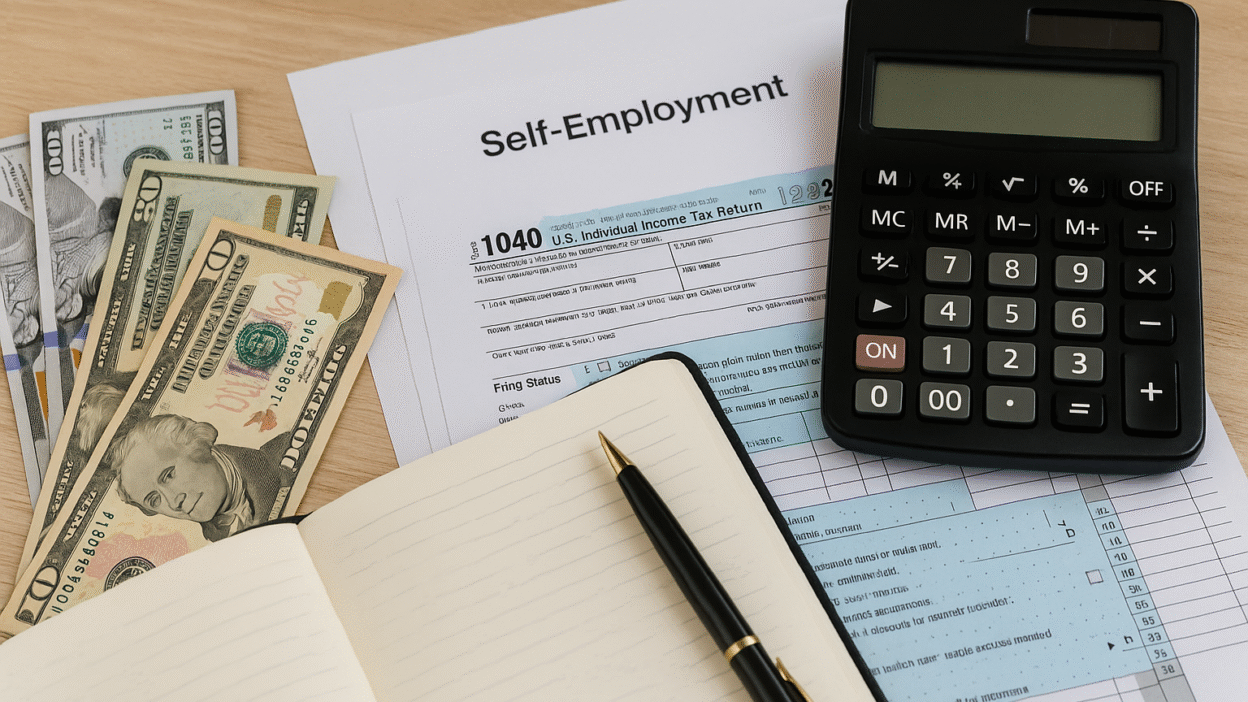Are You Overpaying in Self-Employment Taxes?
If you’re self-employed, chances are you’re paying more in taxes than you legally need to. Shocking, right?
According to IRS data, over 70% of self-employed individuals miss out on deductions they’re entitled to simply because they don’t know they exist. The truth is, knowing how to lower taxes on self-employed income legally isn’t about finding loopholes—it’s about understanding the system and using it wisely.
In this post, we’ll explore practical, legal strategies to reduce your tax bill and help you keep more of what you earn.
Your Financial Toolkit: Essentials for Tax Savings
To start saving legally and effectively, every self-employed person needs a strong financial foundation. Here’s what you’ll need:
- Separate Business Bank Account
Keep personal and business expenses separate to avoid confusion and simplify deductions. - Reliable Accounting Software
Use tools like QuickBooks, FreshBooks, or Wave to automate your bookkeeping and generate tax reports. - Mileage Tracking App
Log business-related travel with apps like Stride or Everlance—every mile counts! - Receipt Management Tools
Scan and save receipts using Expensify or Shoeboxed to prepare for potential audits. - Understanding of Deductible Expenses
Know what you can write off—think office supplies, internet bills, client lunches, and more.
💡 Tip: If spreadsheets aren’t your thing, go with apps that automatically categorize expenses and track income in real time.
How Much Time Do You Need to Plan?
Tax planning doesn’t have to eat your entire week. Here’s a quick breakdown:
- Initial Setup: 90 minutes to get your financial tools organized
- Weekly Upkeep: 10–15 minutes to log expenses and upload receipts
- Quarterly Tax Estimates: 1–2 hours per quarter
- Annual Filing Prep: 2–3 hours to finalize everything
Pro Tip: Set monthly reminders in Google Calendar to check your numbers before tax season sneaks up on you.
Step-by-Step: How to Lower Self-Employed Taxes Legally
Step 1: Track Every Deductible Expense
Log expenses such as software, subscriptions, travel, and meals related to client work.
Step 2: Claim the Home Office Deduction
If you work from home in a space used exclusively for business, deduct part of your rent, mortgage, utilities, and insurance.
Step 3: Maximize Retirement Contributions
Open and contribute to a SEP IRA, Solo 401(k), or Simple IRA. These accounts reduce your taxable income—up to $69,000 in 2024!
Step 4: Deduct Health Insurance Premiums
Self-employed? Deduct your health, dental, and long-term care insurance premiums if you qualify.
Step 5: Write Off Part of Your Self-Employment Tax
You can deduct 50% of your self-employment tax from your adjusted gross income.
Key Financial Metrics That Matter
Here’s the data to support your deductions:
- Self-Employment Tax Rate: 15.3%
- Home Office Deduction (Simplified Method): $5 per sq. ft., up to 300 sq. ft.
- Mileage Deduction: 65.5 cents per mile (2025 rate)
- Solo 401(k) Max Contribution: $69,000
📊 Freelancers lose an average of $4,000 per year in missed deductions due to poor recordkeeping.
Smarter (and Legal) Alternatives
Want to take your savings to the next level?
- Hire Your Kids
Pay them to help with your business and deduct their wages. Children under the standard deduction threshold don’t pay federal income tax. - Switch to an S Corporation
If you make more than $60K per year, forming an S-Corp can help reduce your self-employment tax by paying part of your income as distributions. - Use the Augusta Rule
Rent out your home to your business for up to 14 days a year. Deduct the rent without including it in your personal income.
Real-World Examples: How This Applies
Example 1: Sarah the Freelancer
Sarah earns $90,000/year as a graphic designer. By deducting $10K in expenses, contributing $20K to her Solo 401(k), and writing off her health insurance, she cuts her taxable income down to $50K.
Example 2: Mike the IT Consultant
Mike earns $120K/year. He forms an S-Corp and pays himself $60K in salary and $60K in distributions. This saves him over $5,000 in self-employment taxes.
Common Mistakes to Avoid
Avoid these self-employment tax traps:
- ❌ Mixing business and personal expenses
- ❌ Not filing quarterly estimated taxes
- ❌ Not logging mileage or keeping receipts
- ❌ Overlooking depreciation on office equipment
- ❌ Not adjusting your strategy as income changes
Maintenance and Optimization Tips
Stay on top of your tax strategy with these habits:
- Monthly Reviews
Spend 15 minutes reviewing categorized expenses and income. - Quarterly Check-Ins
Work with an accountant or use online calculators to ensure your estimated taxes are accurate. - Annual Strategy Update
Reevaluate your entity structure and retirement contributions yearly. - Automate What You Can
Use app integrations or tools like Zapier to automate repetitive financial tasks.
Conclusion: Take Action and Keep More of What You Earn
If you’re self-employed, knowing how to lower taxes on self-employed income legally can transform your finances. It’s not about evading taxes—it’s about being informed, strategic, and proactive.
By tracking your expenses, taking legal deductions, and optimizing your tax strategy, you’ll set yourself up for long-term financial health.
👉 Subscribe to YourFinanceWorld.com for more expert insights, free tax guides, and money-smart strategies for freelancers and entrepreneurs.
FAQs
1. What’s the best way to track expenses for tax deductions?
Use apps like QuickBooks or Wave to automate expense tracking and categorize deductions.
2. Can I deduct internet and phone bills?
Yes—if you use them for business. Just deduct the percentage used for work.
3. Do I need to form an LLC to write off expenses?
No, even sole proprietors can deduct qualified business expenses.
4. How much should I save for self-employment taxes?
Save about 25–30% of your net income to cover federal and state taxes.
5. What if I miss a quarterly tax payment?
You may owe interest and penalties. File and pay as soon as possible.
6. Can I still deduct expenses if I file late?
Yes, but penalties may apply. Always file even if you can’t pay in full.
7. Is it worth hiring a tax professional?
Yes. A good accountant can find deductions and optimize your tax setup—especially helpful if you earn over $50K annually.




